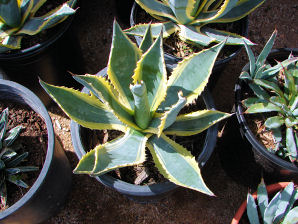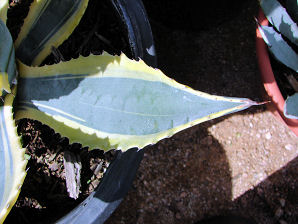Xeriscape Landscape Plants & Flowers
For The Arizona Desert Environment.
Pictures, Photos, Images, Descriptions, & Reviews.
American Agave, Agave americana 'Variegata'.
We Are Proud Of Our SafeSurf Rating!
Click On Any Of The Following Links By Amazon.Com
For Books, & Videos About Wildflowers Of Arizona & The Southwest USA. No Obligation!
| American Agave, Agave americana 'Variegata'. Desert Foothills Gardens, Cave Creek, Arizona, February 27, 2008. |
|---|
 |  |
| American Agave. Agave americana 'Variegata' | American Agave. Agave americana 'Variegata' |
|---|
 /
/

American Agave.
We wish to thank Wikipedia, the free encyclopedia for some of the information on this page. We share images and information with Wikipedia. Agave americana 'Variegata' has gray green foliage that has a thin yellow to white stripe along the leaf margins - this variety of Agave americana is usually referred to as 'Variegata' and it is the most common of the variegated Agave americana varieties. This agave is a succulent recognizable by its thick, graceful, dark gray-green curving leaves a thin yellow to white stripe along the leaf margins. It has projecting spines and its massive stature, reaching 5 - 6 feet tall up and to 10 - 12 feet wide. When the plant matures and blooms a tall candelabra inflorescence rises to over 20 feet bearing yellow flowers that attract many birds and bees. It produces many suckers which can lead to a large colony if the suckers are not removed. It takes full sun and is drought tolerant. It has a massive stature, urceolate form and shiny green leaves with short acuminate leaf tips. The arching leaves are characteristically variegated and have a broad creamy white band down the center of each leaf, with grey-blue sharp-spined edges. Blooms only when the plant is 15 years old or more. The flower stalk is huge (15 to 40 feet), starting like an asparagus, but its flowers are inconspicuous. The plant then dies leaving suckers that grow into replacement plants. This massive and beautiful agave is from the Mexican states of Guanajuato, Oaxaca, and Puebla that forms a dense and very neat rosette of wide, dark green to gray green leaves. In Mexico, Agave is the premier source for the production of pulque (fermented juice of agave or maguey plants). This variety is very closely related to the same plant.
Quick Notes:
Height: 5 to 6 feet tall. It spreads to about 10 - 12 feet.
Flowers: A large stalk emerges from the center of the plant, it becomes 15 to 40 feet tall. Then green to yellow flowers emerge from the terminal end on a horizontal branching structure growing up to 6 feet in diameter. The flowers are green to pale yellow, up to 3 5/8 inches long, with perianth segments erect, up to 1 1/4 inch long, the ovary is shorter than the perianth.
Flowering Time: Phoenix Arizona, Mid March - April. It dies after blooming.
Leaves: The leaves symmetrical, a basal rosette, up to 6 feet long, nearly 12 inches wide, shiny green leaves with short acuminate leaf tips, curved or reflexed at the tip, variegated with a broad creamy white band down the center of each leaf, margin toothed.
Found: Native Central Mexico from the Mexican states of Guanajuato, Oaxaca, and Puebla, Usually in cultivation for pulque.
Hardiness: Said to take temperature down to 18 �F. We don't recommend trying it at that temperature.
Soil pH requirements:
Sun Exposure:
Elevation: 0 - 2,500 feet. In Arizona. 0 - 5,800 Feet. In Mexico.
Habitat: It grows well in sand, sandy loam, clay and other heavy soils. It needs good drainage and aeration. It is remarkably tolerant of alkali. A Xeriscape Landscape plant.
Miscellaneous: Maintenance: Low. Good xeriscape plant. Photos Taken; Desert Foothills Gardens Cave Creek Arizona, February 27, 2008. Susceptible to the snout weevil (Scyphophorus acupunctatus), in the Phoenix area.
|
We Are Proud Of Our SafeSurf Rating!



We Are Proud Of Our SafeSurf Rating!
Click On Any Of The Following Links By Amazon.Com
For Books, & Videos About Xerioscape Plants Of Arizona & The Southwest USA. No Obligation!
Back To Arizona Xeriscape Landscaping Main Page.
Back To Xeriscape Succulents Page Six.
Back To Arizona Wild Flowers Home Page.
Back To DeLange Home Page
© 1966 - Present, Audrey, Eve, & George DeLange
| © 1966 - Present, Audrey, Eve, & George DeLange |

